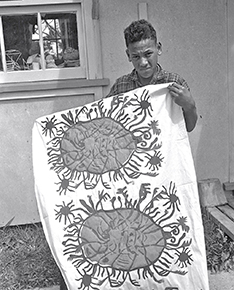Artists, teachers and academics celebrate creative classrooms

Artists, teachers and researchers celebrated the work of renowned educationalist Elwyn Richardson at a symposium with exhibition at AUT University’s North Shore Campus in July.
Collaborative learning
While working at remote Oruaiti School in the Far North in the 1950s, Richardson developed an educational philosophy centred on creative and collaborative learning. He then played a leading role in the introduction of progressive and experimental approaches to teaching in the 1960s and beyond.
Art: a powerful tool
“Elwyn Richardson believed in art as a powerful tool for teaching children. So it was fitting to honour him with a dynamic art exhibition as well as a symposium that explored and reflected on his teaching philosophies,” says event organiser Janita Craw, a senior lecturer at the AUT School of Education.
Exhibition of archival work
Art at Work, an exhibition of archival children’s work and contemporary artists’ work curated by Craw and Victoria O’Sullivan, included work by Jim Allen (a long-standing friend and colleague of Richardson) and potter Barry Brickell. Artist Martin Langdon also helped to bring Richardson’s ideas alive on the day with a hands-on printmaking experience.
Memories refreshed for a former student
One of Elwyn Richardson's former pupils, David Henare (pictured), was at the symposium. Henare has fond memories of his printmaking lessons with Richardson and enjoyed the chance to hear from academics about the educationalist's impact, as well as seeing some of his own prints in the exhibition, for the first time since the 1950s.
Remembering a significant figure in education
Speakers at the symposium included Professor Helen May from the University of Otago, Dr Margaret McDonald, who wrote her doctoral thesis about Richardson, and Dr Joce Jesson from the University of Auckland, also an AUT School of Education Research Associate.Elwyn Richardson, who passed away in December 2012, is remembered as a significant figure in New Zealand’s education history, and his influence continues to have a strong impact on teaching in New Zealand and internationally.
“This event touched a major period in New Zealand educational and art history. The idea behind it was to strengthen the community of interest in art, art education, the history of New Zealand education and progressive education,” says Craw.
For more information visit the symposium website.